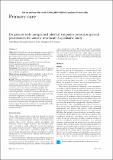Files in this item
Do patients with unexplained physical symptoms pressurise general practitioners for somatic treatment? A qualitative study
Item metadata
| dc.contributor.author | Ring, A | |
| dc.contributor.author | Humphris, Gerald Michael | |
| dc.contributor.author | Humphris, G | |
| dc.contributor.author | Salmon, P | |
| dc.date.accessioned | 2014-04-30T12:31:01Z | |
| dc.date.available | 2014-04-30T12:31:01Z | |
| dc.date.issued | 2004-05-01 | |
| dc.identifier | 352068 | |
| dc.identifier | 7510acc1-50de-4150-8639-bdd8cb5066ea | |
| dc.identifier | 000221174500020 | |
| dc.identifier | 2342593915 | |
| dc.identifier.citation | Ring , A , Humphris , G M , Humphris , G & Salmon , P 2004 , ' Do patients with unexplained physical symptoms pressurise general practitioners for somatic treatment? A qualitative study ' , British Medical Journal , vol. 328 , no. 7447 , pp. 1057-1060 . https://doi.org/10.1136/bmj.38057.622639.EE | en |
| dc.identifier.issn | 0959-8138 | |
| dc.identifier.other | ORCID: /0000-0002-4601-8834/work/64033893 | |
| dc.identifier.uri | https://hdl.handle.net/10023/4672 | |
| dc.description | Funded by the UK MRC | en |
| dc.description.abstract | Objectives To identify the ways in which patients with medically unexplained symptoms present their problems and needs to general practitioners and to identify the forms of presentation that might lead general practitioners to feel pressurised to deliver somatic mterventions. Design Qualitative analysis of audiorecorded consultations between patients and general practitioners. Setting 7 general practices in Merseyside, England. Participants 36 patients selected consecutively from 21 general practices, in Whom doctors considered that patients' symptoms were medically unexplained. Main outcome measures Inductive qualitative analysis of ways in which patients presented their symptoms to general practitioners. Results Although 34 patients received somatic interventions (27 received drug prescriptions, 12 underwent investigations, and four were referred), only 10 requested them. However, patients presented in other ways that had the potential to pressurise general practitioners, including graphic and emotional language; complex patterns of symptoms that resisted explanation; description of emotional and social effects of symptoms; reference to other individuals as authority for the severity of symptoms; and biomedical explanations. Conclusions Most patients with unexplained symptoms received somatic interventions from their general practitioners but had not requested diem. Though such patients apparently seek to engage the general practitioner by conveying the reality of their suffering, general practitioners respond symptomatically. | |
| dc.format.extent | 5 | |
| dc.format.extent | 87617 | |
| dc.language.iso | eng | |
| dc.relation.ispartof | British Medical Journal | en |
| dc.subject | Primary-care | en |
| dc.subject | Doctors | en |
| dc.subject | Gynecologists | en |
| dc.subject | Somatization | en |
| dc.subject | Satisfaction | en |
| dc.subject | Strategies | en |
| dc.subject | Management | en |
| dc.subject | Disorder | en |
| dc.subject | R Medicine (General) | en |
| dc.subject.lcc | R1 | en |
| dc.title | Do patients with unexplained physical symptoms pressurise general practitioners for somatic treatment? A qualitative study | en |
| dc.type | Journal article | en |
| dc.contributor.institution | University of St Andrews. School of Medicine | en |
| dc.identifier.doi | 10.1136/bmj.38057.622639.EE | |
| dc.description.status | Peer reviewed | en |
| dc.identifier.url | http://www.scopus.com/inward/record.url?scp=2342593915&partnerID=8YFLogxK | en |
| dc.identifier.url | http://bmj.bmjjournals.com/ | en |
This item appears in the following Collection(s)
Items in the St Andrews Research Repository are protected by copyright, with all rights reserved, unless otherwise indicated.

